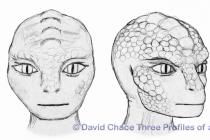The village of Radonezh on the left bank of the river Pages - one of the oldest settlements in the Sergiev Posad region. It was founded by the Slavs around the 11th century. This is confirmed by the name Radonezh - a personal Slavic name Radonezh possessive form.
In the middle of the 12th century, Radonezh became part of the Rostov-Suzdal Principality, and at the beginning of the 13th century, it became part of the Grand Duchy of Vladimir. After the Tatar-Mongol invasion of 1237-1240, the Khan's Baskaks lived here, who monitored the territory entrusted to them and collected tribute. The memory of this is kept by the names of the wastelands - Khanskaya and Baskakova.
Temple in honor of the Transfiguration of the Lord
Closer to the middle of the XIV century, Radonezh became part of the Moscow principality. And in the village grew a large estate with the Church of the Nativity of Christ. In 1328, the Rostov boyar Kirill, the father of St. Sergius of Radonezh, moved to Radonezh with his family. Later, Cyril and Maria took the tonsure at the nearby Khotkov Monastery.
The names of many famous people are associated with the Radonezh land. From these places, the first Kazan archbishop Gury (+ December 4, 1563) comes from and, as historians believe, the brilliant icon painter Andrei Rublev. Radonezh was inspired by the writer Sergei Aksakov and famous artists Mikhail Nesterov and Viktor Vasnetsov.

M. Nesterov. Appearance to the lad Bartholomew
In 1410, Radonezh turned into a town with a fortress, earthen ramparts and three churches, and became the capital of a specific principality owned by Prince Andrei Menshoi. The cathedral temple of the fortress was called Preobrazhensky.
Tsar Ivan III moved the fair to Radonezh, which was held in the Trinity Monastery, and in 1505 bequeathed the city to his son Vasily. During the Polish-Lithuanian invasion, the Radonezh town, or simply Gorodok, was completely destroyed. In 1616, Tsar Mikhail Fedorovich handed it over to the Trinity-Sergius Monastery. The monks converted the tower of the fortress into a tent temple and consecrated it in honor of the Transfiguration of the Lord. A century and a half later, these lands again went to the state.
The new stone Church of the Transfiguration with a chapel of St. Sergius of Radonezh in the refectory was built at the expense of parishioners in 1836-1842. It is considered one of the finest examples of Empire style architecture. The creation of the project is attributed to the architect A.G. Grigoriev. In 1854, the temple was surrounded by a fence with corner towers. At first, it stood separately from the three-tiered bell tower, but in the 1860s they were united by a refectory. Seven bells were installed on the belfry. The largest of them weighed more than three tons. The temple was decorated with two iconostasis at once: a five-tier one in the main part and a two-tier one in the aisle.
In Soviet times Church of the Transfiguration closed. The club moved in in 1941. Later, in the 1960s, the Soviet authorities decided to preserve the Radonezh monuments. In 1974, the temple was put under state protection and restored. For the next two decades, Zagorsky state museum-reserve placed within its walls an exposition dedicated to the history of Radonezh.
One of the most striking local attractions is the monument to St. Sergius of Radonezh. It was designed by sculptor V.M. Klykov and architect R.I. Semerzhiev and installed next to the temple on May 29, 1989. Just a few months later, by decree of the Presidium of the Supreme Soviet of the RSFSR, the village of Gorodok was renamed Radonezh. In the 1990s, the Transfiguration Church was returned Orthodox Church. Now it is the courtyard of the Trinity-Sergius Lavra. It is headed by Abbot Sebastian.

Fragments of paintings from the 1870s have been preserved in the temple. Now the frescoes and the iconostasis have been restored. Opposite the entrance to the temple, an unusual cross has been erected. Once it stood on the grave of the holy blessed Matrona of Moscow. Below, under the mountain, at the source of St. Sergius, two fonts were built.
The most convenient way to get to the village of Radonezh is by car. But you can also take the train along the Yaroslavl railway. From the station "Radonezh" to the Transfiguration Church on foot - 4 kilometers.
Church of the Transfiguration
The village of RadonezhStory. The Church of the Transfiguration of the Lord in the Empire style was built in 1834-1840. at the expense of parishioners and donations. The brick building with the use of white stone in details has a composition characteristic of its time.
The pillarless one-apse quarter of the temple, with lateral porticos of the Doric order, is crowned with a domed rotunda. From the west, it is adjoined by a refectory and a three-tiered bell tower, completed by a cylindrical tier of ringing.
The interiors are decorated with wooden carved iconostasis: the main five-tier iconostasis of the 1890s, the two-tier aisle - 1862. The walls and vaults are covered with oil painting of the 1870s. The brick church fence was restored in 1969 on the model of the former one (1855).
The village of Radonezh on the Page River has an ancient history and is widely known due to the fact that it was here that the exploits of St. Sergius (Bartholomew), who received the nickname of Radonezh, began. The parents of little Bartholomew moved to Radonezh from their estate near Rostov the Great, from where they were forced to leave by constant harassment from the governors of the Moscow prince Ivan Kalita. Boyar Kirill, with his wife Maria and sons Stefan, Bartholomew and Peter, at the invitation of the Radonezh governor Terenty Rtishch, who promised big benefits to the settlers, moved to Radonezh. Later, Cyril and Maria took tonsure in the nearby Khotkov Monastery, and Bartholomew went with them to look after and help their elderly parents.
In the 15th century, Radonezh became a real town with a fortress, earthen ramparts and three churches, the center of a specific principality, which was owned by Prince Andrei Menshoi. The ramparts have survived to this day, but only wooden ones have survived from the three temples. royal doors. The cathedral temple of the fortress was called Preobrazhensky. Under Ivan III, a fair was transferred to Radonezh from the Trinity Monastery. In the 17th century, Radonezh became the patrimony of the Trinity-Sergius Lavra. By this time, the village (or, as indicated in the documents, the “city of Radonezh”) was devastated during the Time of Troubles, and not a single church remained in it. The monastic authorities decided to convert the tower of the fortress into a tent temple. The temple was consecrated in honor of the Transfiguration of the Lord, and two chapels were consecrated in the attached refectory - Sergius of Radonezh and Mikhail Malein.

In the 18th century, the village acquired a new name - Gorodok. The new temple in the village was built at the expense of the parish in the middle of the 19th century in the Empire style. Initially, the main volume of the temple was placed separately from the bell tower, and they were united by a refectory in the 1860s. The main volume is quadrangular, on the sides it is decorated with high porticos in four columns, a high light rotunda is placed on the lower tier. In the main part of the temple, a five-tier iconostasis was placed, in the aisle of Sergius of Radonezh in the refectory - a small two-tier iconostasis. In the 1870s, the temple was painted, and some of these paintings have been preserved.
The three-tiered bell tower is decorated with paired columns and topped with a spire. In 1855, the temple was surrounded by a new brick fence with metal bars. This fence was partially destroyed during the Soviet era, and restored in 1969.
The ancient village has attracted the attention of researchers since the beginning of the 19th century. Largely due to the fact that back in the 1820s it was possible to restore the history of the village, in the 1960s it was decided to preserve its monuments, including the Church of the Transfiguration. In 1974, the temple was placed under state protection. In 1988, a monument to Sergius of Radonezh was erected next to the temple, designed by sculptor V.M. Klykov and architect R.I. Semerzhiev.
In 1989, the village of Gorodok was renamed Radonezh. Now many pilgrims flock here, visiting places associated with the life of one of the most revered and glorified Russian saints - St. Sergius of Radonezh.

Radonezh- a village in the Sergiev Posad district of the Moscow region, 55 kilometers from Moscow.
Story
Located on a cape, on the banks of the river Pages. In its place, a settlement of the Dyakovo type was discovered (early AD). The Slavic settlement, apparently, arose back in the 11th century, in any case, the name - an ancient possessive form from the pagan name "Radoneg" - speaks of its deep antiquity. The village of Radonezhskoe was located on the Pereyaslav road, which led through Moscow to Rostov. It was part of the Rostov-Suzdal, then the Moscow principality. In the first decades of the Tatar yoke, Tatar Baskaks sat there, as evidenced by both local folklore and the names of the tracts "Khan's wasteland" and "Baskakovo". Subsequently, the courtyard of the princely tiun appeared there, with the Church of the Nativity; Radonezh was the center of the volost, according to the hagiographer Sergius of Radonezh Epiphanius, which belonged to the youngest son of Ivan Kalita - Andrey.
Around 1340, the Rostov boyar Kirill, the father of St. Sergius of Radonezh, who later founded the Trinity-Sergius Lavra, 15 km from Radonezh. The high level of education of the monk can be explained by his education in the Rostov Greek schools, which is impossible if we consider that the relocation of the boyar Kirill and his family took place around 1328, as was previously thought. After the death of Ivan Kalita, Radonezh passed by will to his widow Ulyana with her underage sons raised by her from his first marriage and all unmarried daughters of Kalita, but, apparently, due to the death of some children, the estates were redistributed, as a result of which Radonezh was ruled by Andrei Ivanovich. After Ulyana's death (1374), Radonezhskoe belonged to her grandson Vladimir Andreevich Serpukhovsky; then (after his death in 1410) - belonged as the center of the inheritance to his son Andrei Vladimirovich of Radonezh, who turned Radonezh into a town, pouring ramparts (5 m base, and 3 m high; sandy ramparts lined with turf) and building on them wooden Kremlin. The village is now called Gorodok Radonezhsky. Andrei Radonezhsky with all his sons died during the plague of 1426, after which the town passed to his nephew Vasily Yaroslavich Serpukhovsky. The latter during the feudal war consistently supported Vasily the Dark; despite this, the Moscow prince shortly after the death of Dmitry Shemyaka grabbed Vasily (carping on his disputes with the Trinity Monastery) and put him in prison (1456), where he died after spending 27 years in prison; his possessions, including Radonezh, went to Moscow.
Ivan III made the town of Radonezh the center of a special district. In 1491, Ivan III moved the fair to Radonezh, which was held in the Trinity Monastery, and in 1505 bequeathed the city to his son Vasily. Under Vasily or shortly after his death (in the 1530s), a pit (post station) was created in the city, and under Ivan the Terrible there were 40 coachmen. But in general, during the reign of Grozny, the city fell into decay. The Time of Troubles finally finished him off: during Sapieha's campaign against the Trinity-Sergius Monastery (1608-1610), he was completely ravaged by Polish troops and no longer recovered as a city.
In 1616, Mikhail Fedorovich handed it over to the Trinity-Sergius Monastery. During this reign, on the site of Radonezh there were 10 peasant yards and 13 bean yards. The village of Radonezhsky Gorodok, or simply Gorodok, belonged to the monastery (from 1744 - Lavra) until 1764, when the church lands were secularized and transferred to the treasury. In 1842, the stone Church of the Transfiguration was built in the village.
From the Radonezh town, or, now - just the village of Gorodok - comes the first Kazan archbishop Gury (Grigory Rugotin) († December 4, 1563).
In October 1989, by decree of the Presidium of the Supreme Soviet of the RSFSR, the village of Gorodok was renamed the village of Radonezh.
sights
The Church of the Transfiguration was built in 1836-1842. The base is a pillarless quadrangle crowned with a rotunda with eight windows. There is one apse in the eastern wall of the temple, on the north and south sides it is adjoined by porticos with four Doric columns. From the west, a refectory was attached to the temple, since the 1860s it was connected by a narrow passage with a three-tiered bell tower that had previously stood separately. In 1855 a fence was built around the church.
In front of the altar part of the temple there is a five-tier iconostasis, in the aisle of St. Sergius of Radonezh in the refectory there is a two-tier iconostasis. Icons of local masters of the second half of the 19th century. Fragments of wall paintings from the 1870s have been preserved.
Opposite the entrance to the temple there is a cross, which previously stood on the grave of the holy blessed old woman Matrona of Moscow.
On May 29, 1988, a memorial sign was erected at the entrance to the territory of the former citadel (sculptor V. M. Klykov, architect R. I. Semerzhiev). It is a three-meter figure of an old man with a relief image in its middle part of a boy with the image of the Trinity and symbolizes a miraculous meeting that changed life lad Bartholomew, who later became known under the name of Sergius of Radonezh.
Radonezh was founded, presumably, in the 11th century. Slavs settled in the Volga-Oka interfluve. This is evidenced by its name, which is a possessive form of the personal Slavic name Radoneg. Settlements with the name Radonezh existed in the past in Smolensk land, in the upper reaches of the river. Oka (at the junction of modern Kursk and Orel regions) and in the middle reaches of the river. Kirzhach (Vladimir region). Slavs on the territory of the Sergiev Posad region also founded Khotkovo (the name comes from the personal name Khotoneg or Khotobug) on the river. Page, above Radonezh, and Velenezh (from the personal name Veleneg) on the river. Kozelka, the left tributary of the river. Traders. The name of the latter also comes, presumably, from the Slavic name Utrogost (Utrogost-Utorgosh-Torgosh).
Around the middle of the XII century. Radonezh became part of the territory of the Rostov-Suzdal Principality, and in the first quarter of the 13th century. - in the Grand Duchy of Vladimir.
After the Tatar-Mongol invasion of 1237-1240. the principalities of North-Eastern Russia became part of the Golden Horde state. Khan officials conducted a census of the population and imposed tribute on it. The collection of tribute and supervision of the subject territory began to be in charge of the Baskaks. These khan's governors sat, in particular, in Radonezh. This is evidenced by the names of the Khanskaya and Baskakova wastelands, which were located in the vicinity of the settlement. In addition, information about the temple of the White Gods, in which the Baskaks prayed, has been preserved in the people's memory. It was located on a hill rising east of Radonezh.
The stay of the Baskaks in Radonezh was due to the fact that the Pereslavl road passed next to it. Based on the analysis of documents and field surveys of the area, it was possible to localize part of this one of the ancient roads of North-Eastern Russia in the space between the Klyazma and Dubna rivers. According to modern toponymy, the road from the village. Zvyagin of the Pushkinsky district of the Moscow region, lying between the Klyazma and its tributary Ucha, reached the village of Talitsa and then went to the village. Rakhmanov in approximately the same direction as the so-called Staroye Yaroslavl Highway. Then it went north to the village of Novoselki, Sergiev Posad district, here it crossed the river. Voryu, turned east and, leaving Radonezh from the west, crossed the river. Page. Further, passing Radonezh, the road again went north, passing between the villages of Ryazantsy and Morozov and through the eastern outskirts of the village. Semkhoz went to the village. Blagoveshchensky. From here, between the villages of Deulino and Buzhaninovo, it went to the sources of Dubna.
In the second quarter of the XIV century. Radonezh became part of the Moscow principality formed in 1263. The Baskaks were replaced by princely governors. Now they were engaged in tax collection and court cases. For themselves, their assistants and servants, a large estate was built with a church dedicated to the feast of the Nativity of Christ. The principality of Moscow was sparsely populated, therefore, the duties of the governors also included attracting people to the territory under their jurisdiction by providing various benefits. Perhaps seduced by these benefits, in 1332, the Rostov boyar Kirill moved to the Radonezh "whole" with his family and relatives. Epiphanius the Wise wrote about the latter: “This ... servant of God Cyril formerly had a large estate in the Rostov region, he was a boyar, one of the glorious and famous boyars, owned great wealth, but towards the end of his life in old age he became impoverished and fell into poverty.” Probably, the boyar and his wife Maria founded in the second half of the 1330s on Khotkovo the first desert-dwelling Intercession Monastery in the history of the Moscow region.
 After their death, which occurred, presumably, in 1342, their second son Bartholomew decided to also begin a monastic life. Together with his older brother Stefan, who had already taken monastic vows in connection with the death of his wife, Bartholomew went to rch. Konchuru, flowing 15 km north of Radonezh. Here the brothers "... made a bed and a hut and built a roof over it, and then they built one cell and set aside a place for a small church, and cut it down ... the church was consecrated in the name of the Holy Trinity ...". Stefan, seeing "that life is difficult in the desert", soon left for Moscow. Bartholomew, left alone, "... studied all the monastic affairs and monastic orders, and everything else that the monks require." Only after that did he call on hegumen Mitrofan, probably the abbot of the Intercession Monastery, who "tons him in an angelic image", giving him the name Sergius. This event took place on October 7, 1342. The monastic life of St. Sergius consisted of bodily labors, humble meekness, beneficent and without anger miracles, mystical visions and participation in the political life of the Moscow principality (G. Fedotov).
After their death, which occurred, presumably, in 1342, their second son Bartholomew decided to also begin a monastic life. Together with his older brother Stefan, who had already taken monastic vows in connection with the death of his wife, Bartholomew went to rch. Konchuru, flowing 15 km north of Radonezh. Here the brothers "... made a bed and a hut and built a roof over it, and then they built one cell and set aside a place for a small church, and cut it down ... the church was consecrated in the name of the Holy Trinity ...". Stefan, seeing "that life is difficult in the desert", soon left for Moscow. Bartholomew, left alone, "... studied all the monastic affairs and monastic orders, and everything else that the monks require." Only after that did he call on hegumen Mitrofan, probably the abbot of the Intercession Monastery, who "tons him in an angelic image", giving him the name Sergius. This event took place on October 7, 1342. The monastic life of St. Sergius consisted of bodily labors, humble meekness, beneficent and without anger miracles, mystical visions and participation in the political life of the Moscow principality (G. Fedotov).
A feature of the Trinity Monastery of the time of St. Sergius was the desire for contemplation and silence. A similar monastery, which was a school of spiritual work, was later founded by Kirill Belozersky (?-1429), the interlocutor of the monk. After him, the Sergius direction in northern monasticism was continued by Dionysius Glushitsky (? -1437), and after him - Nil Sorsky (? -1508) and Cornelius Komelsky (? -1537). The last representatives of this direction were Diodor Yuryegorsky (? -1633) and Elizar Anzersky (? -1656).
Trinity Monastery was founded on the territory of the Radonezh volost. In view of this circumstance, the nickname "Radonezh" was assigned to St. Sergius. The parish was located between the course of the river. Vori, its left tributary Torshshay and the upper reaches of the river. Veli, a tributary of Dubna. To the west of it was the Beli parish, bounded by the upper course of the Vori, rch. Podmash, the left tributary of the Yakhroma, and the upper reaches of the river. Kokotka, one of the right tributaries of the Vyaz. From the south, another Moscow volost, Vorya, adjoined it, the boundaries of which were the middle course of the river of the same name and the upper reaches of the river. Skalby, the left tributary of the Uchi. To the north and east of the Radonezh volost were Pereslavl, and to the north-west - Dmitrov lands, the Radonezh volost became part of the Moscow lands no later than the reign of Ivan Kalita (1325-1340). Initially, it was the property of the Moscow prince, and after the death of Ivan Kalita, for over a hundred years it was part of various destinies. Its transition from one owner to another was associated with the peculiarity of the historical development of North-Eastern Russia. The Moscow princes, like the rest of the Rurikoviches, looked at the lands they inherited or acquired in some way as their ancestral possessions. Beginning with Ivan Kalita, they divided not only their personal property among their heirs, but also the territory of the principality. The lands allocated to individual male representatives of the clan from the share of the clan property (lot) then became the property of their heirs and began to be divided between them. The women of the clan were given land for life use, and after their death they were usually distributed among the men of the family or clan.
 By the time the Trinity Monastery was founded, the Radonezh volost with another 15 volosts was part of the inheritance of Princess Ulyana. She received them according to the will of her husband, the Grand Duke of Moscow Ivan Kalita, who died in March 1340. The widow-princess herself died no later than 1374. in particular, the Beli and Radonezh volosts went to the latter's cousin, Prince Vladimir Andreevich Serpukhovsky. Now the deputies of the prince, who were sitting in the village of Radonezh, ruled over two adjacent volosts.
By the time the Trinity Monastery was founded, the Radonezh volost with another 15 volosts was part of the inheritance of Princess Ulyana. She received them according to the will of her husband, the Grand Duke of Moscow Ivan Kalita, who died in March 1340. The widow-princess herself died no later than 1374. in particular, the Beli and Radonezh volosts went to the latter's cousin, Prince Vladimir Andreevich Serpukhovsky. Now the deputies of the prince, who were sitting in the village of Radonezh, ruled over two adjacent volosts.
Vladimir Andreevich, probably, while touring his new possessions, met the Trinity abbot and fell under the influence of this outstanding personality. He ordered that henceforth the monastery should allocate part of the food supplies that were collected by the Radonezh governors as a tax in kind (a similar order was made in 1506 by Grand Duke Vasily III regarding the Khotkovsky Intercession Monastery). In addition, he captured St. Sergius at the princely congress in Pereslavl, where he baptized Prince Yuri, the son of Dmitry Donskoy. After the congress, Vladimir Andreevich persuaded the elder to go with him to Serpukhov. “Honest elder Sergius, come to Serpukhov and love a place on Vysokoe and lay that church with your own hands, the Conception of St. Anna, when the Holy Mother of God is conceived and build a monastery.” In 1380, according to legend, he blessed Dmitry Ivanovich Donskoy and Vladimir Andreevich for the Battle of Kulikovo. Thus, thanks to the appanage prince of Serpukhov, the Monk Sergius of Radonezh became involved in the political life of North-Eastern Russia.
Town of Radonezh
The Serpukhov prince died in May 1410. He divided his possessions between his five sons and his wife. His fourth son Andrey got "Radonezh with tamga and from myta. Beli, Chernogolovl ... from the village and with the board ... and with all the duties, Yakovlya Slobidka, Kishkina Slobidka, Tukhachev. In addition, the city of Uglich with the camps was allocated to him and his brother Vasily.
Probably, under Andrei Vladimirovich, the village of Radonezhsky had its own Kremlin, in other words, a fortress, and since then it has been referred to in documents as a town. For the fortification device, a platform was used in the bend of Pages. At a distance of about 10 m from its edge, a sand embankment was made along the entire perimeter, the base of which was 5 m, and the height was 3 m. Then the embankment was lined with turf. Wooden walls were placed on top of it. A ditch was dug from the northeastern floor side of the site, narrowing the passage to the fortress to three meters. The location of the Radonezh fortress on a part of the foot of the hill protruding far towards the river valley indicates, in particular, that it was used primarily as a refuge.
It is known about Prince Andrei of Radonezh that he was married to the daughter of the Moscow boyar Ivan Dmitrievich Vsevolozh. In January 1414, together with his brother Vasily, he participated in the campaign of his second cousin, Prince Yuri Dmitrievich Zvenigorodsky, against the Nizhny Novgorod prince Danila Borisovich. In July 1422, with the participation of Andrei Vladimirovich and Yuri Dmitrievich, the local canonization of St. Sergius of Radonezh was carried out. Probably, at their expense, the white-stone Trinity Cathedral was built in the monastery, for which Andrei Rublev wrote his famous Trinity.
Prince Andrei of Radonezh died, like his brothers, at sea in 1426-1427. The lands of Vladimir Andreevich Serpukhovsky, having lost their owners, passed to Vasily Yaroslavich, his grandson from his third son. Almost all the time of the reign of Vasily Yaroslavich fell on the dynastic war of 1425-1453.
This war was between Grand Duke Vasily II and his uncle Yuri Zvenigorodsky, and then the latter's sons Dmitry Kosy and Dmitry Shemyaka. In February 1446, the Grand Duke went on a pilgrimage to the Trinity Monastery. At this time, his then opponents, princes Dmitry Shemyaka and Ivan Mozhaisky, with the help of conspirators, calmly entered Moscow, captured the mother and wife of Vasily II, plundered his treasury and the houses of his supporters. Ivan Andreevich Mozhaisky went to the monastery to capture Vasily II himself. A certain Bunko warned the Grand Duke that he was in danger of falling into the hands of his enemies. Vasily II did not believe him and, remaining in the monastery, only ordered to set up a guard barrier on the Pereslavl road. The Grand Duke's guards are located on a high mountain near the monastery, where the eastern outskirts of the village are currently located. Semkhoz. Ivan Mozhaisky became aware of the barrier, and he went to the trick. The prince ordered to get a sled, hid a couple of soldiers in them, and ordered one more under the guise of a driver to go next to the sled. The guard of Vasily II, who showed carelessness, was disarmed without much effort by the people of the Mozhaisk prince. Vasily II was captured, taken on a sleigh to Moscow and blinded. Then he was sent to Uglich, which he received into possession as a specific prince. In this war, which ended in 1453 with the victory of Vasily II, Prince Vasily Yaroslavich invariably remained loyal to the Grand Duke. Nevertheless, when in 1456 a conflict broke out between him and the Trinity Monastery, Vasily II ordered the Serpukhov prince to be seized and thrown into prison. Vasily Yaroslavich died in the winter of 1483, having been imprisoned for about 27 years. Immediately after his arrest, Vasily II annexed his possessions to his lands. Thus, from 1456, Radonezh with its subordinate volosts again, and now forever, began to belong to the great Moscow princes.
Under Vasily II, the Principality of Moscow from the ancestral patrimony of the Danilovichs turned into the patrimony of the grand ducal family. His son Ivan III sought, in turn, to turn the principality into the patrimony of one grand duke. Basil II annexed the lands of his cousins to his possessions. Ivan III began to annex the lands of his brothers. In 1472, the childless prince Yuri Vasilyevich Dmitrovsky died. Ivan III, contrary to customary law, did not allocate any parts of this deceived inheritance to his brothers, but declared it all his personal property. Perhaps, in order to better manage his expanded possessions, he decided to create from the volosts of Radonezh and Beli, which were part of the principality of Vasily Yaroslavich, and the volosts of Vorya and Korzenev, which were part of the inheritance of Yuri Dmitrevsky, a new territorial unit - the Radonezh district. The lands of the new county, which arose no later than 1473, were located on both banks of the upper and middle reaches of the river. Thieves. The town of Radonezh was connected by a network of roads not only with Moscow, Pereslavl and Dmitrov, but also with the centers of neighboring volosts and camps, as well as with all large settlements of the county. Nevertheless, due to unknown reasons, it did not become the trade and craft center of the county. It didn’t even help that on September 25, 1492, “in memory of Sergius, the prince transferred the great bargaining from the Trinity to the town in Radonezh.” The artisans of the town, judging by the materials of archaeological excavations, served mainly the governors with their assistants and servants and the townspeople. In the 1530s, a pit station was built in Radonezh. From it, horses and carts were presented to government officials for travel to similar stations located on the Ucha and Dubna rivers. At the end of the XVI century. 40 coachmen served at the Gorodets pit.
During the XV-XVI centuries. all the once free lands of the county ended up in someone else's property. In the middle of the XVI century. about 45 / about the land was in the possession of the Trinity-Sergius Monastery, about 38% belonged to secular persons, about 5% - to several Moscow and Moscow region monasteries, about 1% - to the royal house, and about 1% was listed outside the town. The lands of the latter stretched along both banks of the river. Pages. Northern border from the river. Vori, having reached Page, crossed the latter and walked up the nameless ravine. Having reached its beginning, she turned onto the path that connected the town with the Troitskaya village of Morozov, and went down the path to the RF. Podmash, the left tributary of the Page. Then she went up the Podmash to the Fominsky ravine. The eastern border went up the Fominsky ravine, from its source it passed to the upper reaches of the Oleshkovsky ravine. The southern border from the Oleshkovsky ravine passed to the Mogilitsky ravine, descended along it to the large Gorodetsky ravine and along the latter reached the river. The pages from which she switched to Vorya. The western border went up the Vora from the lands of the palace village of Golygino to the lands of the private village of Arkhanov.
The largest border ravines were used by the Radonezh people for economic purposes. During their field survey, partially eroded earthen dams were found. With the help of the latter, the ravines were turned into ponds. In the upper reaches of the ravine, which flows into the Pazha from the east, a dam has been preserved (length - 16 m, width at the base - 9 m, height - 1.5 m), through which the Radonezh-Morozovo path passed. The dam blocks the middle part of the Fominsky ravine (length - 26 m, width at the base - 8 m, height - 2 m). A small dam blocks the upper part of the Oleshkovsky ravine (length - 17 m, width at the base - 4 m, height - 70 cm). Of the two dams of the Mogilitsky ravine, the one that was built in its middle part (length - 60 m, width at the base - 10 m, height - 2.5 m) has been preserved. The most powerful dam was built in the large Gooden ovoag (length - 30 m, width at the base - 12 m, height - 2 m).
The road Radonezh - Vozdvizhenskoye passed through this dam. On the high left bank of the Page, at the foot of the fortress and 0.5 km from it, two pond dams were built. One end of these dams goes into the river for about one third of its width. The dams slowed down the flow of the water flow, thereby raising its level above the edge of the low right bank. Thanks to this simple trick, part of the river valley was turned into large shallow ponds in two places. According to archaeological research, the town itself occupied an area slightly larger than that on which the modern village is located. The houses of the Radonezh residents stood in several rows at a distance of 10-15 m from each other. On the southwestern outskirts of the town rose wooden church Saints Athanasius and Cyril of Alexandria, near which a cemetery was built.
The church existed until the middle of the 17th century, and then it was dismantled due to dilapidation. The royal gates, decorated with superimposed carved ornaments, have been preserved from it. At the heart of the last braid in the form of a double stem with curls.
Unsuccessful Livonian War 1558-1583 and oprichnina 1565-1572. led to the economic ruin of the center of the Moscow state. In the Radonezh district, the vast majority of secular estates and estates, some monastic and royal possessions, as well as the town itself, were abandoned. Its main inhabitants were coachmen. The fair has again moved to Troitskoye village. Klementyevo. Radonezh, whose formation and development was associated with the first Muscovite dynasty, was fading along with this dynasty.
Gorodok village
At the beginning of the XVII century. The Muscovite state entered a period of internal strife, in which the Commonwealth and Sweden intervened. During the events of the first decade of the XVII century. together with the central part of the state, Radonezh and its environs were completely devastated. Trinity-Sergius Monastery, girdled in the middle of the XVI century. powerful fortress walls, was subjected to a 16-month siege by the detachments of False Dmitry II. From September 1608 to January 1610, its defenders repulsed several assaults, made countless large and small sorties, withstood a month-long artillery shelling and a six-month pestilence. In February 1613, Mikhail Romanov, great-nephew of Ivan the Terrible's first wife, was elected to the vacant Moscow throne. Internal strife began to slowly subside in the state, but the struggle with Sweden and the Commonwealth continued.
In November 1616, Mikhail Fedorovich ordered “dates to the house of the Holy Life-Giving Trinity to the Monk Miracle Worker Sergius in the patrimony” of the never revived town of Radonezh and 12 wastelands, which were previously attributed to the Gorodets pit. In December of the same year, the monastic authorities turned to the tsar with a request to grant them a handful from his court in the neighboring village of Vozdvizhensky, because "there is nothing to put a temple on the town and arrange a monastery yard." Povalusha (a large unheated tower) was converted into a tent church dedicated to the feast of the Transfiguration of the Lord (celebrated on August 6/19). In the refectory attached to it, there were side chapels of the “sovereign angel Mikhail Malein and Sergius of Radonezh”.
In the spring of 1617, the campaign against Moscow of the Polish prince Vladislav began, who in 1610, first by the Tushino and then by the Moscow boyars, was invited to the royal throne. After the unsuccessful assault on Moscow on the night of October 1, 1618, the prince moved along the Pereslavl road further into the interior of the country. Perhaps he intended to capture the Trinity-Sergius Monastery and, on the basis of this success, receive money from the Sejm to continue the war. By this time, the monastery had acquired its own archers and gunners, so Vladislav, having clarified the situation and mindful of the results of his previous siege, decided not to tempt fate anymore. He moved further along the road to the village of Rogachevo and began negotiations. They passed in the village of Deulino, where the Troitsk authorities released "... from the ambassadors of the Radonezh town of the priest Simeon with an honest life-giving cross, gold and beads, and decorated with precious stones ... and with a platter, decorated, and a silver dish." On December 1, the text of the treaty was finally adopted. The letters were laid on a dish, a cross was placed on top of them. The ambassadors approached the lectern in turn and kissed the cross. Then each of the parties signed letters and hung seals. After that, the ambassadors solemnly exchanged the texts of the treaty. The long-awaited peace came to the Muscovite state. So, by chance, the Radonezh priest became a participant in the truce, which put an end to the Polish-Lithuanian intervention. With the onset of peaceful days, the Troitsk authorities quickly managed to populate the new estate by providing benefits and issuing loans to those peasants who agreed to move to Radonezh. By the mid-1620s, there were 10 peasant and 13 bobyl households in the village of Gorodok Radonezhsky, as well as a monastery courtyard, in which “monks to oversee the monastic plowing” lived, and an oxen yard. On the church land there were the yards of the priest, sexton, 4 cells of the poor. A bell tower was added to the Church of the Transfiguration. The inactive church of Saints Athanasius and Cyril of Alexandria still stood on the churchyard. The territory of the churchyard, which was not occupied by the cemetery, was rented out, and it was used as an arable field by local peasants.
At the cemetery of Afanasovsky churchyard at the end of the 17th century. the unfortunate princes Khovansky were buried. In the 1680s, a struggle for power broke out between members of the family of the late Tsar Alexei Mikhailovich. The then head of the Streltsy Order, the aged Prince Ivan Andreevich Khovansky, decided to take advantage of this Kremlin fight. But before he had time to prepare a conspiracy, the kings received a denunciation of him. The entire royal family, under the guise of a prayerful march, moved to the Trinity-Sershev Monastery. Prince I.A. Khovansky was summoned to the village. Vozdvizhenskoye under the pretext of a meeting of the Ukrainian hetman Ivan Samoylovich.
On the way to the village, he was captured along with his eldest son Andrei Ivanovich. In Vozdvizhensky, the Duma clerk Fyodor Shaklovity read to them about their guilt. “And for their betrayal, the great sovereigns ordered to execute them by death, and, answering them, they cut off their heads, and did not indicate to bury them near the church.” According to the Mazurin chronicler, "their bodies were ordered to be buried in Gorodets."
 Until 1764, peasants from. The town was used by the Trinity authorities on the monastic arable land and the barnyard. In 1764, in connection with the secularization of church lands, the village passed into the category of state-owned ones. In 1836-1842. in it, at the expense of the parishioners, a stone Church of the Transfiguration was built with a chapel of St. Sergius of Radonezh in the refectory. The building has a traditional for parish churches of the XVII-XX centuries. three-part longitudinal-axial composition. It is based on a pillarless one-height quadrangle of the temple, completed with an eight-windowed rotunda. A small drum with an octagonal bowl and a cross rises above the rotunda. From the east, a semicircular apse adjoins the temple, and from the north and south sides - four-column porticos of the Doric order. From the west, a rectangular refectory with a gable roof is attached to the temple. Behind the refectory rises a three-tiered bell tower, topped with a spire with a small cross. The apse of the temple and the refectory are decorated with square rustication. The first and second quarters of the bell tower are decorated with flat paired pilasters, completed in the first quarter with a triglyph-metope frieze, and in the second with a triangular pediment. The cylindrical tier of ringing, as in the quadrangles, is cut through by four arched openings. In all tiers, the walls between them are finished with paired pilasters. The altar part of the church is covered by a five-tiered iconostasis, and the southeastern corner of the refectory, where the chapel of St. Sergius of Radonezh is located, is covered by a two-tiered iconostasis. The icons in them were painted by local masters in the second half of the 19th century. The fragmentary preserved wall painting dates back to the 1870s. In 1855, a brick fence with a metal lattice and round turrets at the corners was erected around the church. In the 1860s, the bell tower, which stood separately, was connected to the refectory by a narrow passage.
Until 1764, peasants from. The town was used by the Trinity authorities on the monastic arable land and the barnyard. In 1764, in connection with the secularization of church lands, the village passed into the category of state-owned ones. In 1836-1842. in it, at the expense of the parishioners, a stone Church of the Transfiguration was built with a chapel of St. Sergius of Radonezh in the refectory. The building has a traditional for parish churches of the XVII-XX centuries. three-part longitudinal-axial composition. It is based on a pillarless one-height quadrangle of the temple, completed with an eight-windowed rotunda. A small drum with an octagonal bowl and a cross rises above the rotunda. From the east, a semicircular apse adjoins the temple, and from the north and south sides - four-column porticos of the Doric order. From the west, a rectangular refectory with a gable roof is attached to the temple. Behind the refectory rises a three-tiered bell tower, topped with a spire with a small cross. The apse of the temple and the refectory are decorated with square rustication. The first and second quarters of the bell tower are decorated with flat paired pilasters, completed in the first quarter with a triglyph-metope frieze, and in the second with a triangular pediment. The cylindrical tier of ringing, as in the quadrangles, is cut through by four arched openings. In all tiers, the walls between them are finished with paired pilasters. The altar part of the church is covered by a five-tiered iconostasis, and the southeastern corner of the refectory, where the chapel of St. Sergius of Radonezh is located, is covered by a two-tiered iconostasis. The icons in them were painted by local masters in the second half of the 19th century. The fragmentary preserved wall painting dates back to the 1870s. In 1855, a brick fence with a metal lattice and round turrets at the corners was erected around the church. In the 1860s, the bell tower, which stood separately, was connected to the refectory by a narrow passage.
 In the 1870s, a zemstvo elementary school began to operate in the village. At the end of the XIX century. There were 55 households in the village. The peasants of the village, like everyone else in the district, sowed rye, oats, peas, planted potatoes. Due to the lack of land and its low fertility, many of them became servants, engaged in weaving and carpentry, and worked as foil makers at nearby enterprises. At the beginning of the XX century. Zemstvo authorities allowed the use of the settlement for a cemetery, which had previously been given either as an arable field, or as a pasture.
In the 1870s, a zemstvo elementary school began to operate in the village. At the end of the XIX century. There were 55 households in the village. The peasants of the village, like everyone else in the district, sowed rye, oats, peas, planted potatoes. Due to the lack of land and its low fertility, many of them became servants, engaged in weaving and carpentry, and worked as foil makers at nearby enterprises. At the beginning of the XX century. Zemstvo authorities allowed the use of the settlement for a cemetery, which had previously been given either as an arable field, or as a pasture.
From the first quarter of the 19th century the village of Gorodok began to attract the attention of historians, archaeologists, lovers of antiquity. In 1821 he was visited by the Polish researcher of the antiquities of the Slavic peoples ZD Khodakovsky. In his “Report on the first successes of travel in Russia”, he noted the presence of a settlement in the village and a field called White Gods next to the settlement. Professor of Moscow University I.M. Snegirev in a number of his guidebooks of the 1840-1850s, dedicated to the Trinity-Sergius Lavra and the Trinity Road, for the first time introduced a wide circle of readers to the history of the settlement and its monuments. In the XX century. much attention was paid to Radonezh by archaeologists. Thanks to the efforts of Yu.G.Gendune, TSH.Milonov, S.3.Chernov, V.I.Vishnevsky and A.E.Bushuev, it was possible to identify the pre-Slavic history of the settlement, clarify its topography, collect significant material related to the economic activity and life of the Radonezh people .
In the 1960s-1980s, a number of decisions were made by government agencies aimed at preserving the monuments of Radonezh and its historical landscape. In 1960, the settlement was put under state protection as an archeological monument of republican significance, and in 1974, as an architectural monument of republican significance, the Church of the Transfiguration was placed. In 1986, the Moscow Regional Executive Committee decided to establish protection zones for the town of Radonezh. The project of these zones was developed by the researchers of the Mosoblstroyrestavratsiya trust A.I. Semenova, T.V. Bugayeva and S.Z. Chernov (See the illustration. Click to enlarge). The northern border of the protection zones begins near the Abramtsevo platform, runs south of the city of Khotkovo and between the city and the village. Semkhoz turns to the southeast, and then through the forest goes to the Yaroslavl highway north of the village of Ryazantsy. The eastern border descends from the Yaroslavl highway south to the west of the villages of Kirimovo, Shelkovo and Lychovo and reaches the village of Barkovo in the Pushkinsky district. The southern border goes from Barkovo to the west and north of the village. Rakhmanov comes out krch. Twilight. The western border goes from Sumeri to the north and near the village of Antipino, Sergiev Posad district, turns northwest to the railway track, then it goes along the track behind the Abramtsevo platform. Thus, the protection zone is located in the southwestern part of Sergiev Posadsky and 2/4 of the northeastern part of the neighboring Pushkinsky district of the Moscow region.
 On May 29, 1988, to the south-west of the Transfiguration Church of the village, a memorial sign was erected to St. Sergius of Radonezh (sculptor V.M. Klykov, architect R.I. Semerzhiev). I.M. Snegirev, in one of his articles on Radonezh, wrote: “Here it is impossible not to rejoice in the place consecrated to the existence of the shrine of temples and the stay of the Reverend Founder of the House of the Holy Trinity and overshadowed by the invisible presence of Angels - their guardians. Radonezh is worthy of a monument corresponding to it, which would indicate to the passer-by pilgrim the traces of the great ascetic, lover of the fatherland, supporter of Russian weapons, peacemaker and miracle worker. May the place not be holy empty! 133 years later, his call was heard. The base of the memorial sign is an oval one and a half meter high hill. On its flat top, a three-meter figure of an old man in a monastic robe froze. The half-lowered head of the monk is covered with a cockle pulled over his forehead. The elder's eyes are closed, his hands are prayerfully folded on his chest. In the middle part of the figure, the stone is slightly selected, and the figurine of the boy Bartholomew protrudes from the outlined oblong niche. He is dressed in a loose shirt and soft pants tucked into onuchi. The boy has sandals on his feet. With wide-open eyes, Bartholomew looks over the Radonezh hills. In his hands he holds a carved icon, in the center of which, in a circle, the Old Testament Trinity is depicted.
On May 29, 1988, to the south-west of the Transfiguration Church of the village, a memorial sign was erected to St. Sergius of Radonezh (sculptor V.M. Klykov, architect R.I. Semerzhiev). I.M. Snegirev, in one of his articles on Radonezh, wrote: “Here it is impossible not to rejoice in the place consecrated to the existence of the shrine of temples and the stay of the Reverend Founder of the House of the Holy Trinity and overshadowed by the invisible presence of Angels - their guardians. Radonezh is worthy of a monument corresponding to it, which would indicate to the passer-by pilgrim the traces of the great ascetic, lover of the fatherland, supporter of Russian weapons, peacemaker and miracle worker. May the place not be holy empty! 133 years later, his call was heard. The base of the memorial sign is an oval one and a half meter high hill. On its flat top, a three-meter figure of an old man in a monastic robe froze. The half-lowered head of the monk is covered with a cockle pulled over his forehead. The elder's eyes are closed, his hands are prayerfully folded on his chest. In the middle part of the figure, the stone is slightly selected, and the figurine of the boy Bartholomew protrudes from the outlined oblong niche. He is dressed in a loose shirt and soft pants tucked into onuchi. The boy has sandals on his feet. With wide-open eyes, Bartholomew looks over the Radonezh hills. In his hands he holds a carved icon, in the center of which, in a circle, the Old Testament Trinity is depicted.  At the base of the hill lies a parallelepiped with the inscription: "Grateful Russia to Sergius of Radonezh."
At the base of the hill lies a parallelepiped with the inscription: "Grateful Russia to Sergius of Radonezh."  In October 1989, by decree of the Presidium of the Supreme Soviet of the RSFSR, the village of Gorodok was renamed the village of Radonezh.
In October 1989, by decree of the Presidium of the Supreme Soviet of the RSFSR, the village of Gorodok was renamed the village of Radonezh.
In preparation for the 700th anniversary of the birth of St. Sergius, the courtyard was being restored, including the construction of a pouring font for the disabled, children and old people.
This chapel was brought from Greece, near the city of Thessaloniki, assembled by the Kudashkin brothers personally within 3 hours approximately, illuminated on February 17, 2013 from R.Kh. In the chapel itself there is a cross from the grave of the blessed Matrona of Moscow.
Sources
1. Brief contemplation of Sylvester Medvedev // Readings of the Society of Russian History and Antiquities. 1894 Book 4. M., 1894.
2. Spiritual and contractual letters of the great and specific princes of the XIV-XVI centuries. M.; L., 1950.
3. Complete collection of Russian chronicles. M., 1965. T. 30 Chronicler of Vladimir.
4. Complete collection of Russian chronicles. M „ 1966. T. 31 Mazurin chronicler.
5. Project of protection zones of the ancient city of Radonezh. Documentation for Soviet and economic bodies and land users. M., 1986.
Literature
1. Reports on the first successes of travel in Russia by Zoriyan Dolugi-Khodakovsky // Russian historical collection. M., 1844. T. 7. C, 6-7.
2. Snegirev I.M. Radonezh - the town of ashes of St. Sergius of Radonezh // "Russian invalid". 1855 No. 237, November 1.
3. Snegirev I.M. Guide from Moscow to the Trinity-Sergius Lavra. M „ 1856.
4. The life of the reverend and God-bearing father of our Sergius the Wonderworker and the eulogy to him, written by his disciple Epiphanius in the 15th century. SPb., 1885.
5. Milonov N.P. Archaeological exploration in the city of Radonezh // Historical and archaeological collection. Moscow, 1948, pp. 65-73.
6. Chernov S.Z. Historical landscape of ancient Radonezh: origin and semantics // Monuments of Culture. New discoveries. 1988. M., 1989. S. 412-438.
7. Georgy Fedotov. Saints of Ancient Russia. M., 1990.
8. I.M. Kontsevich. The acquisition of the Holy Spirit in the ways of Ancient Russia. M., 1993.
9. Vishnevsky V.I. Ancient Radonezh // Sergiev Posad Museum-Reserve. Messages. 1995. M „ 1995. S. 12-30.
10. Tkachenko V.A. Letter of grant from Tsar Mikhail Fedorovich "to the house of the Blessed Life-Giving Trinity St. Sergius the Wonderworker” to the town of Radonezh with wastelands in the Moscow district dated November 5, 1616 // Sergiev Posad Museum-Reserve. Messages. 1995. M., 1995. S. 38-49.
A village in the Sergiev Posad district of the Moscow region, 55 kilometers from Moscow.
The village of Radonezh is located in the southern part of the Sergiev Posad district, between the 59th km of the Yaroslavl highway and the Abramtsevo platform of the Northern Railway. Geographically, Radonezh is located at the base of the southern slope of the Klin-Dmitrovskaya ridge, on the left bank of the Pazha River. In its place, many centuries ago, there was an ancient Slavic settlement. Archaeological excavations point to a settlement of the Dyakovo culture that existed in Radonezh (early AD), then to a Slavic settlement of a later time. The oldest archaeological find on the territory of Radonezh is a bronze belt pendant in the form of a bear, an amulet. Such items were found mainly in the Kama region, they belong to the 7th-8th centuries and testify to the Finno-Ugric presence. In the region of Radonezh, there apparently existed a settlement of the Merya tribe, subsequently assimilated by the Slavic population who came to these lands in the 9th-10th centuries. The name Radonezh comes, most likely, from the possessive form of the proper Old Slavic name Radoneg.
In the first decades of the Mongol-Tatar yoke, Tatar Baskaks lived in Radonezh, as evidenced by both local folklore and the names of the tracts "Khan's wasteland" and "Baskakovo". The first written evidence of the village of Radonezh and the Radonezh volost dates back to 1336. They are mentioned in the will of the Grand Duke of Moscow Ivan Kalita as being transferred to the property of his second wife Ulyana. At that time, Radonezh was one of the largest settlements on the northeastern borders of the Moscow lands. The favorable geographic location in the Pazhi bend, on a high hill, on the way from Moscow to Rostov the Great determined its strategic importance. The hill fort was a fortified manor of the princely governor with a suburb adjoining it. In the 14th century, when the grandson of Princess Ulyana, the hero of the Battle of Kulikovo, Prince Vladimir Andreevich (1353-1410) of Serpukhov, there was a marketplace and a customs outpost in Radonezh. Under his son Andrei of Radonezh (1380s - 1426), the city became the center of a small specific principality and reached its peak. At that time, Radonezh turned into a fortified citadel with high earthen ramparts surrounded by a moat and a wooden fortress with towers. Near its walls there was a hem, a cemetery and the Church of the Nativity.
The Moscow principality was sparsely populated, therefore, the duties of the princely governors also included attracting people to the territory under their jurisdiction by providing various benefits. In 1332, the Rostov boyar Kirill moved with his family and relatives to “the whole of Radonezh,” constrained by circumstances, in the hope of improving his situation. According to Epiphanius the Wise, "that ... servant of God Cyril formerly had a large estate in the Rostov region, he was a boyar, one of the glorious and famous boyars, owned great wealth, but towards the end of his life in old age he became impoverished and fell into poverty." Raising their children to their feet, at the end of their lives, the spouses Kirill and Maria took the tonsure in the cenobitic Khotkovo Intercession Monastery, located a few kilometers from Radonezh. After their death, which occurred, presumably, in 1342, their second son Bartholomew decided to also begin a monastic life. Together with his older brother Stefan, he went to the desert life in the forests near the Konchura River and Makovets Mountain and took monastic vows with the name Sergius on October 7, 1342. Soon the Trinity fraternal monastery appeared on this site, which later became the Trinity-Sergius Monastery, and then the Lavra. Trinity Monastery was founded on the territory of the Radonezh volost. In view of this circumstance, the name "Radonezhsky" was assigned to St. Sergius. Saint Sergius of Radonezh was canonized in 1449.
Cyril and Maria of Radonezh, the parents of St. Sergius, were buried in the Khotkovsky Intercession Monastery and canonized in 1992.
Prince Andrei of Radonezh with all his sons died during the plague of 1426, after which the town passed to his nephew Vasily Yaroslavich Serpukhovsky. The latter during the feudal war was on the side of Vasily the Dark; despite this, soon after the death of Dmitry Shemyaka, the Moscow prince seized Vasily (carping on his disputes with the Trinity Monastery) and put him in prison (1456), where he died after spending 27 years in prison. All his possessions, including Radonezh, went to Moscow.
Ivan III made Radonezh the center of a special district. In 1491, Ivan III moved the fair to Radonezh, which was held in the Trinity Monastery, and in 1505 bequeathed the city to his son Vasily. Under Vasily or shortly after his death, a pit (post station) was created in the city, and under Ivan the Terrible there were already 40 coachmen there. But in general, during the reign of Grozny, the city fell into decay. The final desolation of the town of Radonezh falls on the Time of Troubles. The Polish voivode Jan Sapieha, during a campaign against the Trinity-Sergius Monastery (1608-1610), ravaged Radonezh to the ground, after which he never recovered. In 1616, Mikhail Fedorovich handed it over to the Trinity-Sergius Monastery. During this reign, on the site of Radonezh there were 10 peasant yards and 13 bean yards. The village of Radonezhsky Gorodok, or simply Gorodok, belonged to the monastery
(c 1744 - Lavre) until 1764, when church lands were secularized and transferred to the treasury. In 1842, the stone Church of the Transfiguration was built in the village.
The first Kazan archbishop Gury (Grigory Rugotin) comes from Radonezh
sights
Church of the Transfiguration in Radonezh
The Church of the Transfiguration was built in 1836-1842. The base is a pillarless quadrangle crowned with a rotunda with eight windows. In the eastern wall of the temple there is one apse, from the north and south sides it is adjoined by porticos with four Doric columns. To the west, a refectory was attached to the temple, since the 1860s connected by a narrow passage with a three-tiered bell tower that had previously stood separately. In 1855 a fence was built around the church.
In front of the altar part of the temple there is a five-tiered iconostasis, in the aisle
St. Sergius of Radonezh in the refectory, a two-tiered iconostasis. Icons
local craftsmen of the second half of the 19th century. Fragments of wall paintings from the 1870s have been preserved.
Opposite the entrance to the temple there is a cross that stood on the grave of the blessed saint
old lady Matrona of Moscow.
Not far from the temple there is a chapel in the name of the Kazan Mother of God over the holy spring of St. Sergius of Radonezh.
memorial sign
The memorial sign (sculptor V.M. Klykov, architect R.I. Semerzhiev) was installed on May 29, 1988 at the entrance to the territory of the former citadel in honor of the 1000th anniversary of the baptism of Russia and in honor of the 600th anniversary of the repose of St. Sergius of Radonezh. It is a three-meter figure of an old man - St. Sergius of Radonezh with a relief image in its center of a boy with the image of the Trinity - the youth Bartholomew.
ramparts
The ramparts of the 15th century have been preserved. However, at present, there is a cemetery on the territory of the former citadel, and, despite the formal ban, graves are also arranged on the ramparts themselves.














